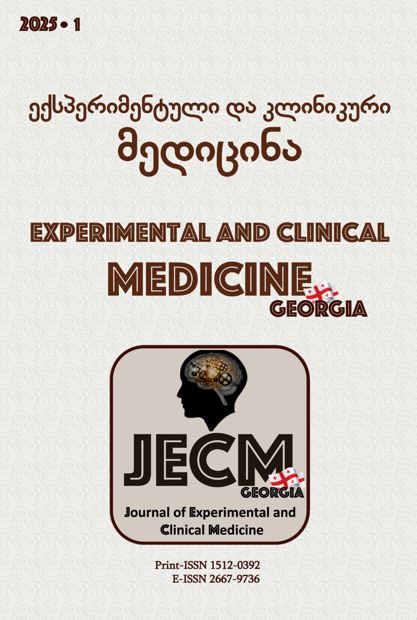ლაქტოზით გლიკირებული ციტოქრომ C-ს ელქტრონული მიმოცვლის და თერმული სტაბილურობის კვლევა
DOI:
https://doi.org/10.52340/jecm.2025.01.20საკვანძო სიტყვები:
Cytochrome C, Glycation, Lactoze, cyclic voltammetry, calorimetry, electron transferანოტაცია
შესწავლილია ლაქტოზით გლიკირებული ციტოქრომ C-ს ელექტრონული მიმოცვლის სიჩქარე და თერმული მდგრადობა გლიკირების 14 დღიან პერიოდში (T = 25 0C). ციტოქრომ C-ს და მოდიფიკატორით დაფარულ ოქროს ელექტროდს შორის ჟანგვა-აღდგენითი რეაქციის სიჩქარე და თერმოდინამიკური მდგრადობა ცილის გლიკირების პროცესის სხვადასხვა ეტაპზე გაზომილი იქნა, შესაბამისად, ციკლური ვოლტამპერომეტრიის და მიკრო კალორიმეტრული მეთოდის გამოყენებით. მიღებული ექსპერიმენტული შედეგები მიუთითებს იმაზე, რომ ლაქტოზით გლიკირება იწვევს ციტოქრომ C-ს რედოქს აქტივობის მკვეთრ გაუარესებას გლიკირების პერიოდის დაწყებიდან ერთი კვირის შემდგომ, მაშინ როცა ცილის გლობალური თერმული სტაბილობა შენარჩუნებულია გლიკირების მინიმუმ ორკვირიან პერიოდში.
Downloads
წყაროები
Dolidze T., Makharadze M., Uchaneishvili S., Khoshtariya D. Impact of prolonged glycation pre-treatment on the electron transfer kinetics of cytochrome C. Experimental and Clinical Medicine Georgia. 2024, (2), 11–13. https://doi.org/10.52340/jecm.2024.02.02 .
Schachinger F., Scheiblbrandner S., Karnpakdee K., et al. Cytochromes as electron shuttles from FAD-dependent glucose dehydrogenase to electrodes Electrochimica Acta. 2023, 458 142485.
Scott R. A., Mauk A. G. Cytochrome C. A. Multidisciplinary Approach; University Science Books: Sausalito. 1996.
Guerra-Castellano A., Márquez I., Pérez-Mejías G., Díaz-Quintana A., De la Rosa M.A. and Díaz-Moreno I. Post-Translational Modifications of Cytochrome c in Cell Life and Disease. Int. J. Mol. Sci. 2020, 21, 8483; doi:10.3390/ijms21228483.
Fedurco M. Redox reactions of heme-containing metalloproteins: dynamic effects of self-assembled monolayers on thermodynamics and kinetics of cytochrome c electron-transfer reactions. Coordination Chemistry Reviews. 2000, 209(1), 263–331. doi:10.1016/s0010-8545(00)00292.
Sharma G. S., Warepam M., Bhattacharya R., & Singh L. R. Covalent Modification by Glyoxals Converts Cytochrome c Into its Apoptotically Competent State. Scientific Reports. 2019, 9(1). doi:10.1038/s41598-019-41282-2.
Cussimanio B.L., Booth A.A., Todd P., Hudson B.G., Khalifah R.G. Unusual susceptibility of heme proteins to damage by glucose during non-enzymatic glycation Biophysical Chemistry 2003, 105, 743–755.
Hildick-Smith G.J., Downey M.C., Gretebeck L.M., Gersten R.A., Sandwick R.K. Ribose 5-Phosphate Glycation Reduces Cytochrome C Respiratory Activity and Membrane Affinity. Biochemistry. 2011, 50, 11047–11057.
Delgado Y., Morales-Cruz M., Hernández-Román J., Martínez Y. and Griebenow K. Chemical glycosylation of cytochrome c improves physical and chemical protein stability. Delgado et al. BMC Biochemistry. 2014, 15:16 http://www.biomedcentral.com/1471-2091/15/16.
Sol R. J., Rodriguez-Martinez J. A. and Griebenow K. Modulating protein biophysical properties by chemical glycosylation: biochemical insights and biomedical implications. Cell. Mol. Life Sci. 64. 2007, 2133 – 2152. DOI 10.1007/s00018-007-6551-y.
Khoshtariya D.E., Dolidze T.D., Seyfert S., Sarauli D., et al. Kinetic, thermodynamic and mechanistic patterns for free (unbound) Cytochrome C at Au/SAM junction. Impact of electronic coupling, hydrostatic pressure, and stabilizing/denaturing additives. Chem. Eur. J. 2006, 12 (27), 7041-7056.
Dolidze T.D., Khoshtariya D.E., Waldeck D.H., Macyk J. & van Eldik R. Positive activation volume for a cytochrome c electrode process: Evidence for a "protein friction" mechanism from the high-pressure studies. J. Phys. Chem. B. 2003, 107, 7172-7179.
Nicholson R.S., Theory and Application of Cyclic Voltammetry for Measurement of Electrode Reaction Kinetics, Anal.Chem. 1965, 37,1351-1355.
Machado J.B., Coutinho J.A., Macedo E.A. Solid-liquid equilibrium of a-lactose in ethanol/water. Fluid Phase Equilibria 173. 2000, 121–134.






